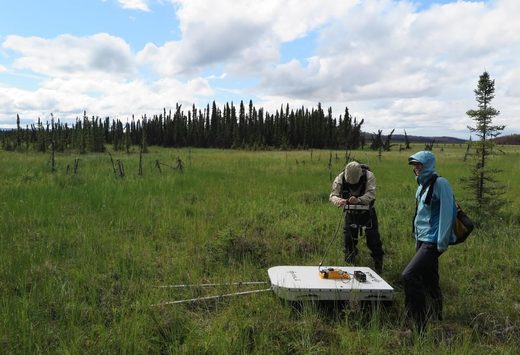
A recent study estimates permafrost coverage on the peninsula has decreased by 60 percent since 1950.
Permafrost is usually associated with Northern and Interior Alaska, but it also occurs in isolated pockets in wetlands on the Kenai Peninsula.
Benjamin Jones is a research geographer with the U.S. Geological Survey and one of the study co-authors.
"We installed ground temperature loggers connected to a data logger so we were recording ground temperatures on an hourly basis on a two and a half to three year time period," said Jones. "Based on that data collection we were able to confirm that yes there is permafrost present in some of these wetland complexes on the Kenai Peninsula."
To be classified as permafrost, the ground must remain below 0 degrees Celsius for at least two consecutive years.
The Kenai Peninsula's warm air temperatures mean these permafrost islands are particularly vulnerable to thaw.
Based on aerial photography, Jones estimates permafrost coverage on the Kenai Peninsula has decreased by 60 percent since 1950.
Warming air temperatures are one of the main reasons for the permafrost thaw, but Jones says there are other contributing factors.
"Fire is a pretty active disturbance mechanism when it comes to permafrost degradation or permafrost thaw. It basically burns off the forest cover and burns some of the surface peat that's acting to protect these permafrost deposits on the Kenai Peninsula," said Jones.
Comment: Heat from below may also be a contributing factor. See: SOTT Exclusive: The growing threat of underground fires and explosions
Permafrost on the Kenai Peninsula is mostly confined to islands of black spruce in wetlands. Without that insulating layer of spongy peat moss and spruce, permafrost is much more vulnerable to thaw.
Permafrost may be hidden underfoot, but Jones says the effects of extensive thawing are anything but.
"It's the foundation for which a lot of Alaska is built upon. Permafrost influences roughly 80 percent of the subsurface of the state, so permafrost thaw can affect infrastructure, including roadways, buildings and pipelines," said Jones.
When permafrost thaws, the ground sinks and can lead to the collapse of roadways and buildings, along with coastal erosion.
Moving forward, Jones and his colleagues will be working to better understand the complex drivers of permafrost thaw across Alaska.
Their findings were published in the November issue of Cryosphere.



Reader Comments
to our Newsletter